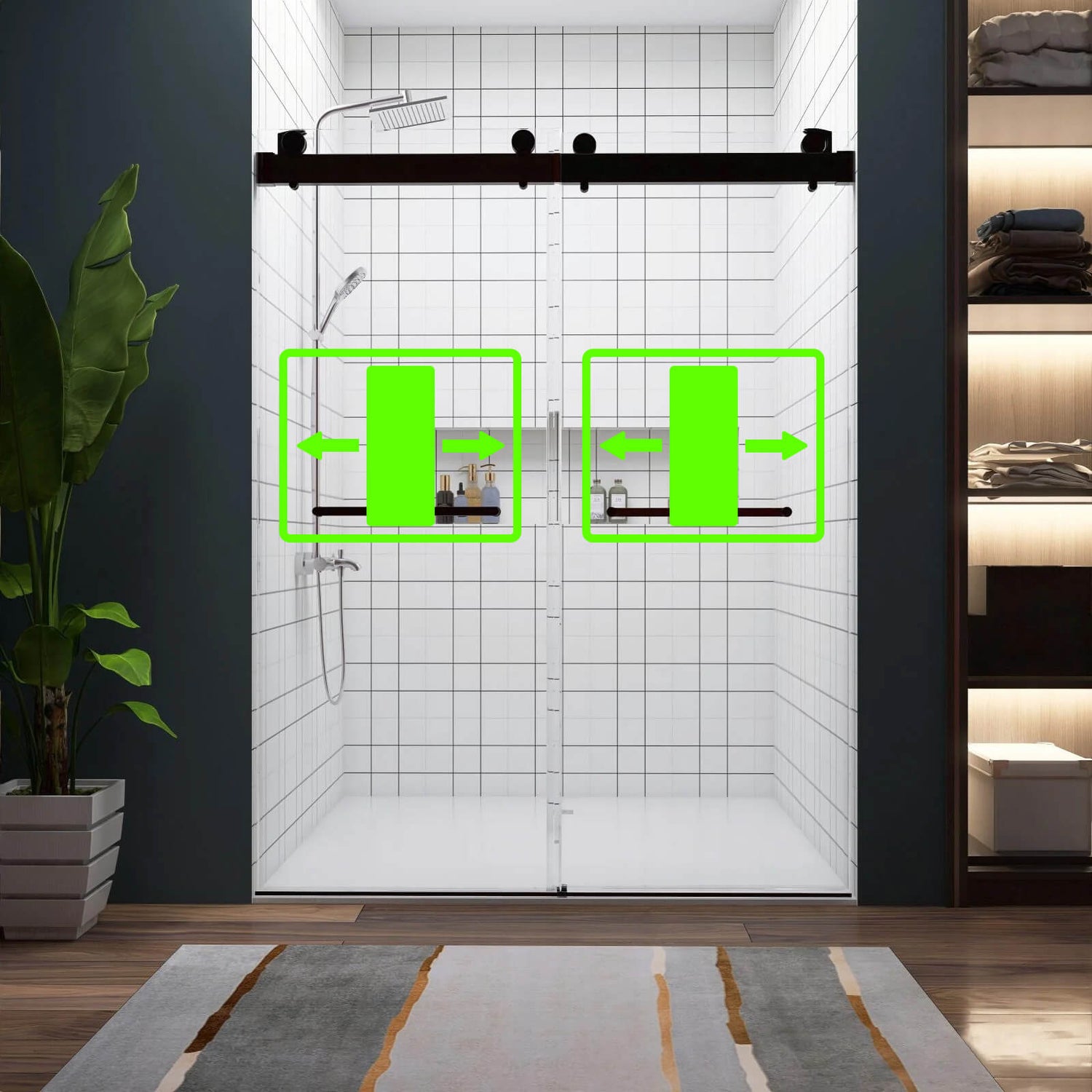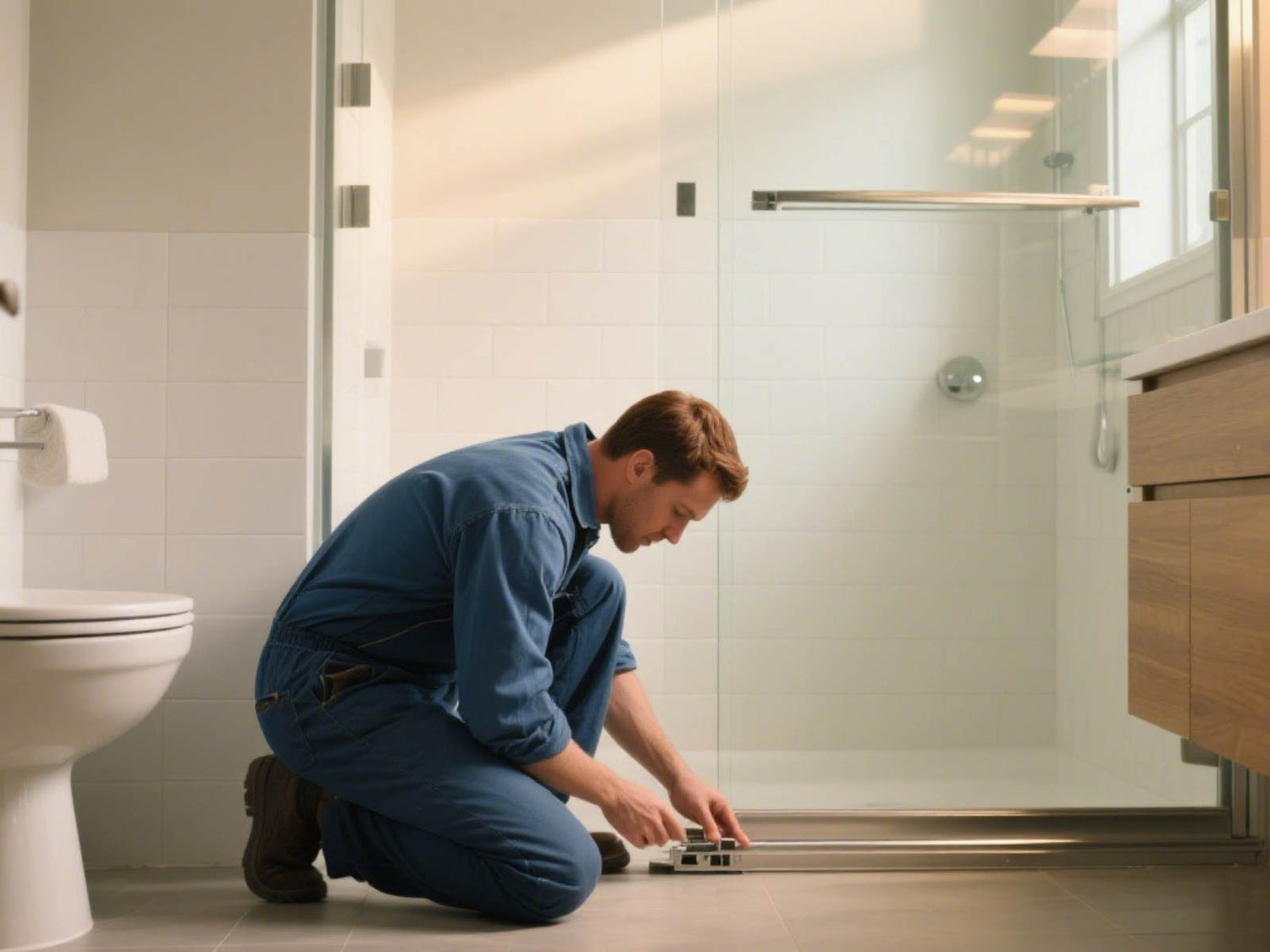In modern home renovations, the shower is increasingly replacing the traditional bathtub as the focal point of the bathroom. Choosing the right shower door system is a key decision in creating the ideal bathing space. Many homeowners renovating their bathrooms often find themselves puzzled between single sliding and dual sliding shower doors. While these two options may appear similar at first glance, they differ significantly in terms of function, space utilization, and user experience. So how should we choose? Let us find out in this article!
Understanding Sliding Shower Door Basics

Single Sliding Shower Doors
In fact, when we mention sliding shower doors, we usually refer to single sliding shower doors, which feature a one-way sliding design, typically consisting of one fixed glass panel and one movable glass door. Its most distinctive characteristic is the presence of only one bottom track, along which the sliding door glides horizontally, opening from one end to allow entry.
Structurally, the system is relatively simple—an aluminum or stainless steel track is embedded in the floor, with a guiding groove above to keep the door vertically stable. The roller system is hidden at the top of the door frame, ensuring smooth operation and a clean visual appearance.

Dual Sliding Shower Doors
Dual sliding shower doors, commonly referred to in the industry as "bypass shower doors," feature a dual-track parallel design with two independently movable door panels. These panels can slide in opposite directions, most commonly opening from the center outward or vice versa.
Structurally, it requires two parallel tracks (usually spaced about 2–3 inches apart), with rollers on each door running along both tracks. The upper frame includes a more complex guiding system to ensure synchronized movement. Note that a greater wall width is typically required because of the overlapping doors.
Single vs. Dual Sliding Shower Doors
| Comparison Criteria | Single Sliding Shower Door | Double Sliding Shower Door |
|---|---|---|
| Structural Complexity | Simple (single track) | More complex (dual track) |
| Required Installation Space | Minimum 48-inch width | Minimum 48-inch width |
| Ease of Use | Simple one-way operation | More flexible two-way operation |
| Sealing Performance | Good | Good |
| Price Range | $300–$1,200 | $500–$2,500 |
| Cleaning Difficulty | Easier to clean track | Slightly more complex cleaning |
| Suitable Bathroom Type | Medium/Large | Medium/Large |
| Lifespan | 8–12 years | 8–12 years |
| Installation Difficulty | Easier (possible DIY) | Professional installation advised |
| Kid/Elderly Friendly | Moderate | Higher (larger opening available) |
How to Choose the Right Sliding Shower Door System
Contrary to common assumptions, the choice between a single or dual sliding shower door in a home bathroom is not strictly determined by the width of the shower opening. Both types are generally suitable for shower spaces ranging from 40 to over 60 inches in width. For particularly small bathrooms, however—especially those under 36 inches wide—neither sliding system is ideal. Instead, a pivot shower door or a simple shower screen may be more practical.
Budget, on the other hand, does play a more significant role in the decision-making process. On average, dual sliding shower doors cost 30–50% more than single sliding options of comparable quality, depending on materials, hardware, and frameless designs. Therefore, if price is a determining factor and other needs are equal, a single sliding door offers a more cost-effective solution.
When it comes to aesthetics, minimalists may be drawn to dual sliding doors, particularly frameless designs that deliver a clean, seamless look. In contrast, single sliding doors typically have one fixed panel, which requires some form of visible framing. This structural requirement makes them slightly less visually minimal, though they still suit contemporary spaces well.
For homeowners concerned with maintenance and long-term ease of cleaning, single sliding doors offer an advantage. With only one track, there's less surface area for grime buildup and fewer moving parts subject to wear. Over time, all sliding door tracks can accumulate dirt and experience friction damage, but maintaining a single-track system is simpler and more efficient.
In conclusion, while space is not a limiting factor for choosing between single and dual sliding shower doors, considerations such as budget, design preference, and ease of maintenance should guide your selection. For compact bathrooms, consider alternative systems.
Professional Maintenance Guide for Sliding Shower Doors

For Track Systems
It’s recommended to use a soft brush weekly to remove hair and soap scum buildup, and clean deeply once a month with a neutral cleaner (such as diluted white vinegar). Important: avoid cleaners with chlorine or abrasive ingredients, which can corrode the track surface. After cleaning, you can apply a small amount of silicone-based lubricant (e.g., WD-40 specialty door track lubricant) to the track to reduce friction noise and extend the life of the rollers.

For Glass Panels
Use professional glass cleaners and microfiber cloths. Stubborn water stains can be treated with citric acid solutions. If your glass panels are coated (e.g., fingerprint-resistant coating), make sure to use cleaners recommended by the manufacturer to avoid damaging the special coating. The sealing strips are crucial for leak prevention—check them quarterly for hardening or cracks, and replace them promptly if needed. While universal seals are available, using original manufacturer parts ensures the best fit.

Troubleshooting
If the door doesn’t slide smoothly, first check for deformed tracks or obstructions.
If the door wobbles, it may be necessary to tighten the upper guide screws.
For leaks, inspect the bottom threshold and seal strip alignment.
Even for high-quality sliding shower doors, it’s advisable to have a professional inspection and tune-up every 2–3 years to prevent minor issues from becoming major failures. This is especially important for complex double sliding systems, which rely on precise calibration of the synchronized mechanism.
Ending
Choosing a shower door system is essentially a choice about lifestyle and spatial philosophy. The single sliding door’s simplicity and efficiency reflect the modern pursuit of practicality, while the double sliding door’s elegance and flexibility reveal a desire for elevated living quality. No matter which system you choose, remember: a quality shower door is not just a functional partition—it is the visual centerpiece and experiential core of your bathroom space.
More Ideas
-

How to Create an Ergonomically Designed Bathroom
Imagine stepping into a bathroom where everything just works — the sink is right where you need it, the shower head hits at the perfect angle, and even the towel...
-

What Makes the Most Comfortable Soaking Tub?
Discover what makes the most comfortable soaking bathtub — from angle, depth, and shape to design tips that elevate every soak into a relaxing, spa-like ritual at home.
-

Is It Safe to Use a Hot Tub During Your Period
Those few days each month can feel like a sweet burden — the backaches, cramps, bloating, and constant second-guessing of what’s safe to do. Can I eat cold foods? Work...
-

4 Eco-Friendly Bathroom Ideas to Support Your Sustainable Home
Climate change, extreme weather, and dwindling resources are no longer distant concerns—they’ve become part of our daily reality. Traditional bathrooms, unfortunately, tend to be far from eco-friendly: they waste water,...
-

Does a Hot Tub Really Help You Burn Calories and Lose Weight?
Everyone wants to look and feel their best. Lately, you’ve probably seen claims like: “Spending 15 minutes in a hot tub is the same as a 10-minute walk,” or “Soak...
-

Can You Use a Hot Tub During Pregnancy?
Pregnancy often brings unique needs and heightened sensitivity—and that’s completely understandable. What feels perfectly normal in everyday life might require a little more caution when you’re expecting. One common question...






